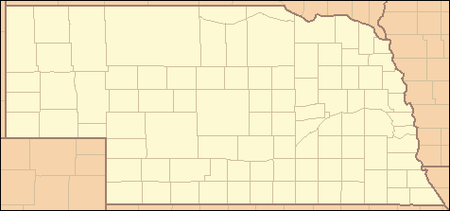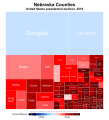Portal:Nebraska
The Nebraska PortalMigrating sandhill cranes (Antigone canadensis) depart their overnight roosting area in the Platte River near Kearney, Nebraska, at dawn (2015).
 Nebraska (/nəˈbræskə/ nə-BRASS-kə) is a landlocked state in the Midwestern region of the United States. It borders South Dakota to the north; Iowa to the east and Missouri to the southeast, both across the Missouri River; Kansas to the south; Colorado to the southwest; and Wyoming to the west. Nebraska is the 16th-largest state by land area, with just over 77,220 square miles (200,000 km2). With a population of over 1.9 million, it is the 38th-most populous state and the eighth-least densely populated. Its capital is Lincoln, and its most populous city is Omaha, which is on the Missouri River. Nebraska was admitted into the United States in 1867, two years after the end of the American Civil War. The Nebraska Legislature is unlike any other American legislature in that it is unicameral, and its members are elected without any official reference to political party affiliation. Nebraska is one of only two states that divide electoral college votes by district, and is not winner-take-all. Nebraska is composed of two major land regions: the Dissected Till Plains and the Great Plains. The Dissected Till Plains region consists of gently rolling hills and contains the state's largest cities, Omaha and Lincoln. The Great Plains region, occupying most of western Nebraska, is characterized by treeless prairie. Eastern Nebraska has a humid continental climate while western Nebraska is primarily semi-arid. The state has wide variations between winter and summer temperatures; the variations decrease in southern Nebraska. Violent thunderstorms and tornadoes occur primarily during spring and summer, and sometimes in autumn. The Chinook wind tends to warm the state significantly in the winter and early spring. Indigenous peoples, including Omaha, Missouria, Ponca, Pawnee, Otoe, and various branches of the Lakota (Sioux) tribes, lived in the region for thousands of years before European discovery and exploration. The state is crossed by many historic trails, including that of the Lewis and Clark Expedition. The completion of the Transcontinental Railroad through Nebraska and passage of the Homestead Acts led to rapid growth in the population of American settlers in the 1870s and 1880s and the development of a large agriculture sector for which the state is known to this day. (Full article...) Selected article - The University of Nebraska–Lincoln (Nebraska, NU, or UNL) is a public land-grant research university in Lincoln, Nebraska, United States. Chartered in 1869 by the Nebraska Legislature as part of the Morrill Act of 1862, the school was the University of Nebraska until 1968, when it absorbed the Municipal University of Omaha to form the University of Nebraska system. It is the state's oldest university and the flagship institution of the state-wide system. The university has been governed by the Board of Regents since 1871, whose members are elected by district to six-year terms. The university is organized into nine colleges: Agricultural Sciences and Natural Resources, Architecture, Arts and Sciences, Business, Education and Human Sciences, Engineering, Fine and Performing Arts, Journalism and Mass Communications, and Law. NU offers over two hundred degrees across its undergraduate, graduate, and doctoral programs. The school also offers programs through the University of Nebraska Omaha College of Public Affairs and Community Service, the University of Nebraska Medical Center College of Dentistry and College of Nursing, and the Peter Kiewit Institute, which is managed in partnership with the Kiewit Corporation. (Full article...) Selected biography - Doris Stevens (born Dora Caroline Stevens; October 26, 1888 – March 22, 1963) was an American suffragist, woman's legal rights advocate and author. She was the first female member of the American Institute of International Law and first chair of the Inter-American Commission of Women. Born in 1888 in Omaha, Nebraska, Stevens became involved in the fight for suffrage while a college student at Oberlin College. After graduating with a degree in sociology in 1911, she taught briefly before becoming a paid regional organizer for the National American Woman Suffrage Association's Congressional Union for Woman Suffrage (CUWS). When the CUWS broke from the parent organization in 1914, Stevens became the national strategist. She was in charge of coordinating the women's congress, held at the Panama Pacific Exposition in 1915. When the CUWS became the National Woman's Party (NWP) in 1916, Stevens organized party delegates for each of the 435 Congressional Districts in an effort to attain national women's enfranchisement and defeat candidates who were opposed to women's rights. Between 1917 and 1919, Stevens was a prominent participant in the Silent Sentinels vigil at Woodrow Wilson's White House to urge the passage of a constitutional amendment for women's voting rights and was arrested several times for her involvement. After the 19th Amendment secured women's right to vote, she wrote a book, titled Jailed for Freedom (1920), which recounted the sentinel's ordeals. (Full article...) Counties (clickable map)General images -The following are images from various Nebraska-related articles on Wikipedia.
Did you know -
Related portalsTopicsLargest cities
CategoriesNew articlesThis list was generated from these rules. Questions and feedback are always welcome! The search is being run daily with the most recent ~14 days of results. Note: Some articles may not be relevant to this project.
Rules | Match log | Results page (for watching) | Last updated: 2024-11-01 21:17 (UTC) Note: The list display can now be customized by each user. See List display personalization for details.
WikiProjectsAssociated WikimediaThe following Wikimedia Foundation sister projects provide more on this subject:
Sources
|




































